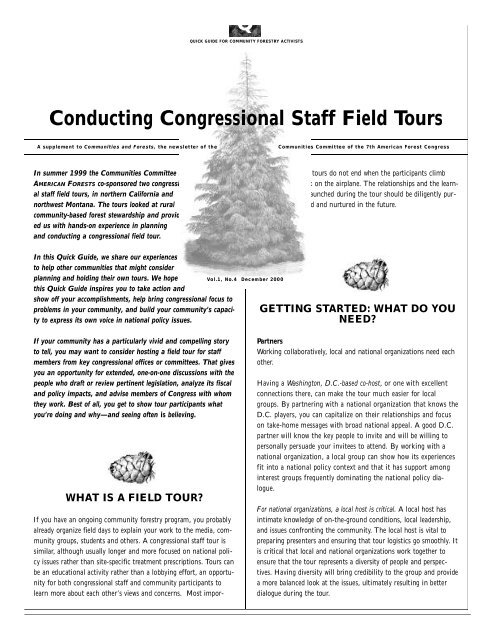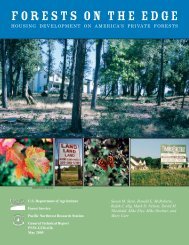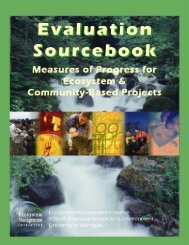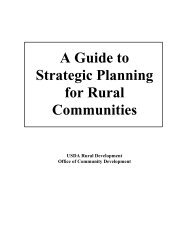Conducting Congressional Staff Field Tours - Communities Committee
Conducting Congressional Staff Field Tours - Communities Committee
Conducting Congressional Staff Field Tours - Communities Committee
You also want an ePaper? Increase the reach of your titles
YUMPU automatically turns print PDFs into web optimized ePapers that Google loves.
QQUICK GUIDE FOR COMMUNITY FORESTRY ACTIVISTS2. Formal presentations—as opposed to informal discussions.• What topics should be covered?• Who should present?• How long should presentations last? The shorter, the better.Encourage presenters to provide only essential information and to tie itclearly to the problems and issues identified as the subject of the tour.The idea is to better inform tour participants, not to make them expertsabout your program.• Prepare “Leading questions” in case the post-presentation discussionsneed a push.3. Time for conversation—Allow ample of time for discussion, and makesure congressional staff members don’t talk just to each other.Encourage congressional and local people to mingle and talk at meals,during rides to and from field sites, at breaks, and more.4. Free time—Don’t overload the agenda. Especially in the evenings,make sure congressional staff have some time to relax.TOUR LO G I S T I CSPlanning the tour1. Use a mix of activities (indoor presentations, outdoor site visits,meal and break times) to tell your community’s story and to ke e pparticipants alert and interested.2. Consider various transportation options—motor coaches, buses,vans, or others—comparing costs, insurance, and use restrictions.Some bus and car rental agencies do not permit vehicles to be usedoff-road or on unpaved roads. Make sure your drivers know wherethey are going, especially if you will be traveling off main roads.Provide good maps.3. Keep driving times as short as possible, and identify places andactivities of interest to be pointed out along the way.4. Schedule frequent rest stops, and provide mid-morning and midafternoonsnacks. Have a supply of bottled water and other beveragesavailable at all times.5. Allow enough time for leisurely meals. A lot of good discussionoccurs over a second cup of coffee.6. Prepare a list of important phone numbers (emergency #’s,presenters, the caterer or the restaurants where meals are beings e rved, and more.) so you can call ahead if you get off schedule.Have a cell phone with you.7. Make sure you know about and have provided for any audio- v i s u-al aids participants will need.8. Confirm all arrangements in writing: time, place, number ofpeople, cost, and responsibilities.9. Do a “dry run” of presentations to ensure that speakers’ messageswill be on target and within time limits. This is probably themost important pre-tour activity that you will do. Having a conferencecall or meeting in-person allows all the tour presenters andparticipants to understand the flow of the tour and when certainissues are going to be discussed. A “dry run” also works out timingissues, reduces surprises, and helps the presenters and hosting communityunite around the message.We organized our stops around specific themes. This gave each presentera time when they had the spotlight and helped everyoneunderstand how to support the discussions that followed. Westrongly advise that if you are partnering with a national organizationthat you invite your distant partners to partake in this part oflocal planning.10. Discuss in advance how to handle discussions where consensusdoes not exist among participants or the tour sponsors. Explainthat differing opinions exist, and that the group feels it is importanthave all views expressed.11. Remember to focus on the message. You do not need a uniformpoint of view, but you do need to keep the discussion focused. Thetour is not the time to air “dirty laundry. ”Special Considerations1. Alcoholic beverages—As tour hosts you need to determine whetheryou want or can use your grant funds to pay for alcoholic beverages.We chose not to pay for alcohol and most participants were veryunderstanding. We did, however, make transportation available toattendees to purchase their own liquor at the local grocery store,liquor store, or bar.2. Non-business-related activities (fishing, sightseeing, city tours, andmore.)—Offering a short sightseeing excursion or recreationalactivity during a free period or before or after planned activities maym a ke the tour more inviting to potential attendees. Generally, howev e r, your funds and time should be spent on tour-related activities.<strong>Congressional</strong> participants may want to schedule vacation timebefore or after the tour, perhaps bringing their families. You can be
QQUICK GUIDE FOR COMMUNITY FORESTRY ACTIVISTShelpful to them in making arrangements. We chose not to do so.Most staff understood and appreciated the time that communitymembers donated to be there.The pre-tour packet<strong>Congressional</strong> staff probably will not have time to read your backgroundmaterials until they are the plane, so the packet should bedesigned for easy use. A three-ring binder is ideal. It shouldi n c l u d e :1. A narrative orientation to the tour area and existing communityforestry programs2. Area maps and descriptions of projects to be visited3. A copy of the final itinerary4. Participant and presenter bios and contact information5. Pertinent articles or other information that addresses the mainissues to be explored or help set the tour into a larger policy context6. Information about accommodations (address, fax, telephone #s)7. Emergency telephone numbers in case of missed flights or otherp r o b l e m sLocal participants should receive complete packets as well. Thesewill show them what congressional staff have been given as backgroundand clarify questions on the tour.After we completed our tours, many local groups said that having acomplete copy of the packet helped them during the tour, but alsoa f t e rward when members of their community asked about the tour.The advance packet works as an effective communication tool. TheCalifornia tour packet also included presentation summaries, whichpeople found helpful before, during, and after the tour.<strong>Conducting</strong> the tour1. Watch the clock. Stay on schedule if at all possible.2. Watch the participants. Are they engaged? bored? bewildered?Are local folks and <strong>Congressional</strong> staffers mingling?3. Fill in gaps and help guide presentations and discussions if theystart to wander4. Have one of the facilitators keep track of unresolved issues andquestions to be addressed at a later time.5. Keep reinforcing how particular sites or discussions relate back tothe tour’s main themes.6. Make sure conversation is not all one way; that is, ensure that atsome times during the tour (at the wrap-up session and elsewherewhen appropriate) the congressional staffers are asked how, specifica l l y, they could contribute to solving the problems and issues identi f i e d .7. Be prepared to punt. If something doesn’t go as planned, justdeal with it. Don’t worry about fault.8. Keep your sense of humor and smile.Post tour1. Send a thank-you letter to each guest and presenter.2. <strong>Congressional</strong> staffers will need (ASAP) a record of what youspent on each of them (transportation, lodging, meals), they needthis to turn in with their report to the Ethics <strong>Committee</strong>.3. All participants should receive a tour evaluation form.• A stamped, self-addressed return envelope will increase thereturn rate• Include questions that will help you find out how well this tourwent and how to make the next one better4. Do a de-briefing with local participants, and send them a summaryof the written evaluation results.Long-term follow- u p1. Stay in touch with participating <strong>Congressional</strong> staffers.• Be concise when you call or write• When possible, relate your comments to something they saw orheard on the tour. Doing so will add context and help them relateto how the issue affects real people and places2. Keep participants briefed on what you are doing—the feedbackyou received about the tour and the problems identified. Send articles,newspaper clippings, newsletter items, and other relevant materi a l s .3. Ask participants what they have been doing4. Make suggestions about what participants could be doing.• Be specific• Make it as easy as possible for them to do what you want. Offerassistance with formulating legislation, finding people to testify, andm o r e .• Be positive and proactive. Don’t criticize without offering analternative solution.5. Don’t expect too much too soon—but don’t expect too little.
QQUICK GUIDE FOR COMMUNITY FORESTRY ACTIVISTSAcknowledgments and CreditsWritten by: Carol Daly and Maia EnzerProduction and copyediting: Janine GuglielminoThis Quick Guide was written in consultation with CeciliaDanks and Lynn Jungwirth, who organized the California fieldtour, and with Carol Daly, who organized the Montana field tour.It was reviewed by all members of the Policy task group.This Quick Guide is one of a series of policy tools developed bythe Policy Task Group of the <strong>Communities</strong> <strong>Committee</strong> of theSeventh American Forest Congress. Please direct comments toany of the people listed below. All members of the <strong>Communities</strong><strong>Committee</strong> are welcome to join this task group.Kathryn MutzNatural Resources Law CenterK a t h r y n . M u t z @ c o l o r a d o . e d uKevin SmithOffice of Governor John Kitzhaberk s m i t h @ s s o . o r gThis Quick Guide is a joint publication of the <strong>Communities</strong><strong>Committee</strong> of the Seventh American Forest Congress andAM E R I C A N FO R E S T S. Financial support is provided by the Fo r dFoundation, the Surdna Foundation, and the U.S. Forest Serv i c e ,State and Private Fo r e s t r y.To request additional copies, please contact:Policy Task Group Members:Maia J. Enzer, Co-Chair Policy Task GroupSustainable Northwestm e n z e r @ s u s t a i n a b l e n o r t h w e s t . o r gMichael Goergen, Co-Chair Policy Task GroupSociety of American Fo r e s t e r sg o e r g e n m @ s a f n e t . o r gJim BeilNY Department of Environmental Conserv a t i o nj a b e i l @ g w. d e c . s t a t e . n y. u sThomas BrendlerNational Network of Forest Pr a c t i t i o n e r st b r e n d l e r @ i g c . a p c . o r gGerry GrayVice President, Po l i c yAM E R I C A N FO R E S T SP. O. Box 2000Washington, DC 20013g g r a y @ a m f o r. o r g(202) 955-4500 ext. 217(202) 955-4588 faxBulk orders of this or previous Quick Guides can be purchased fora minimal charge. Smaller quantities are provided free.Previous Quick Guide topics include: The Appropriation Pr o c e s s ,Media Strategies for Community Practitioners, and the Fe d e r a lBudget Pr o c e s s .Carol DalyFlathead Economic Policy Centerc d a l y @ d i g i s y s . n e tJuan MendozaWillamette Valley Re s t o r a t i o nw v r d p @ m o l a l l a . n e tMary MitsosPinchot Institute for Conserv a t i o nm m i t s o s @ c o m p u s e rv e . c o mAnn MooteUdall Center for Studies in Public Po l i c ym o o t e @ a g . a r i z o n a . e d u
QQUICK GUIDE FOR COMMUNITY FORESTRY ACTIVISTS<strong>Communities</strong> and Forests/Quick Guide<strong>Communities</strong> <strong>Committee</strong> of theSeventh American Forest CongressPO Box 356Hayfork, California 96041






